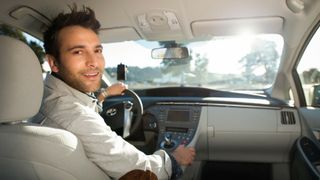Smile! Uber is using selfies to verify your driver's identity
Before they pick you up, of course

Uber is taking safety seriously, so it's expanding a means for US drivers to verify their identity before they pick up riders. One that involves, oddly enough, selfies.
Real-Time ID Check will have drivers snap and share a selfie with Uber before they start ferrying passengers. The tech taps into Microsoft Cognitive Services to crosscheck the selfie against the account Uber has on file.
"This prevents fraud and protects drivers' accounts from being compromised," Uber security chief Joe Sullivan writes in a blog post. "It also protects riders by building another layer of accountability into the app to ensure the right person is behind the wheel."

Drivers will be asked periodically to take a selfie in the Uber app before they can accept rides. Uber will instantly compare the photo using Microsoft Cognitive Service, which can recognize facial features, to the one the company has on file.
If the pics don't match, Uber will temporarily lock the account and look into the matter.
During tests of Real-Time ID Check, Uber found that most mismatches happened due to unclear profile pictures. More than 99% of drivers were verified once everything was sorted, the ride-sharing service says.
Uber has put a focus on safety lately, including introducing GPS and smartphone monitoring to see whether drivers are speeding or hitting the brakes too hard.
Get daily insight, inspiration and deals in your inbox
Get the hottest deals available in your inbox plus news, reviews, opinion, analysis and more from the TechRadar team.
While a selfie safety check sounds a bit trivial, it could help make rides safer for passengers and foster trust between Uber users, drivers and the company at large. Thankfully, Uber is asking drivers to snap a selfie before they pick you up, not during your ride.
Michelle was previously a news editor at TechRadar, leading consumer tech news and reviews. Michelle is now a Content Strategist at Facebook. A versatile, highly effective content writer and skilled editor with a keen eye for detail, Michelle is a collaborative problem solver and covered everything from smartwatches and microprocessors to VR and self-driving cars.
Most Popular



